It’s Salary & Benefits Survey time!
Now available for you to fill out and benefit from is GrowerTalks and Green Profit’s annual Salary & Benefits Survey, which we’ve been doing for nearly three decades now!
But now, for the second year in a row, we’ve partnered with AmericanHort to help us take the survey to an even higher level and make it even more useful for you. That’s because they’ve brought in research firm Industry Insights, which does this sort of work for many industries.
Why should you bother? Because companies that take the survey can better understand salary and benefit trends and see how their businesses compare to other survey participants. The survey includes company demographics, staffing and benefits, and salary data on up to 34 different job titles across full-time, part-time and seasonal employees.
Another reason to participate? You might win a Yeti Tundra 45 cooler! (a $325 value).
CLICK HERE to fill out the survey (which is confidential collected and maintained by Industry Insights’ professional data team and securely stored). You don’t have to be an AmericanHort member to benefit; all survey respondents will get the full report prepared by Industry Insights. And, of course, the data will be published in the December issue of GrowerTalks (January for the retail report in Green Profit). But AmericanHort members will also receive a bonus report at no charge.

White’s auction rescheduled, expanded
After the sad news that White’s Nursery & Greenhouses of Chesapeake, Virginia, has closed after nearly 70 years in business, the next phase was to be an auction of all the equipment—a great opportunity to have part of a venerable business live on and inspire others! Only there were serious software glitches by the original auction firmed hired to do the job, so the sale was scratched. Now, they’ve brought in a new company, Rasmus Auctions, to handle the liquidation of the business assets. And they’re doing it in a two-phase format: commercial and industrial-grade equipment, and then tools and equipment for the local business community (and even gardeners).
Phase 1 on October 9 will include the sale of large-scale greenhouse structures, specialized horticultural equipment and other capital assets critical to commercial growing operations. This includes a variety of X.S. Smith greenhouses, boilers, irrigation booms, ECHO hanging basket systems and more.
Phase 2 on October 10 will include hand tools, power tools, golf carts, retail equipment and gardening supplies ranging from containers to tomato stakes. This phase offers a unique opportunity for smaller operations to acquire high-quality equipment and supplies.
The auctions will begin at 6:00 p.m. both days and will go fast—five to seven items every two minutes.
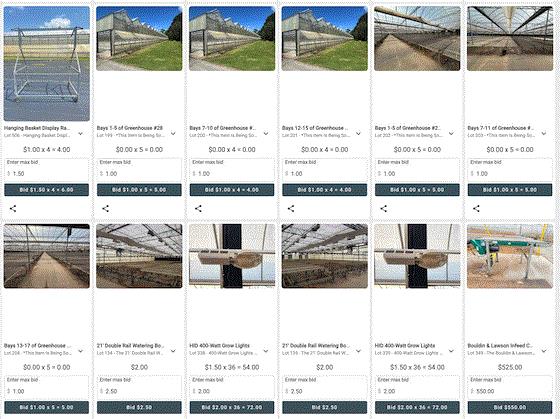
Said the press release, “For industry professionals, this auction represents a rare opportunity to acquire well-maintained, high-quality assets from a storied nursery. Whether you’re looking to expand your existing operations or enter the horticultural market, the White’s Nursery auction offers an unparalleled selection of equipment and supplies.”
Interested buyers will have the opportunity to inspect the assets in person at White’s Nursery & Greenhouses on October 7 and 8, from 10:00 a.m. to 4:00 p.m. at 3133 Old Mill Road, Chesapeake, Virginia.
To view the full catalog of available items and register for the auction, click on either of the two phases (or the photo) above.

Just to recap what led to this
I’m reprinting this from the bottom of the auction press release, as a reminder about how White’s found themselves in this position:
Founded in 1956 by Norm and Hetty White, White’s Nursery & Greenhouses grew to become a leading producer of premium potted flowering plants and annuals, serving a loyal customer base across the mid-Atlantic region. The nursery’s commitment to quality, innovation and customer service earned it a revered place in the horticultural community.
However, the challenges of a capital and labor-intensive industry, compounded by reduced demand, rising interest rates and the withdrawal of financial support, led to the difficult decision to close the wholesale side of the business.

“This is a bittersweet moment for our family,” said Tal White of White’s Nursery. “We’ve put our hearts into this business for generations, and while it’s difficult to see it end, we’re committed to ensuring a smooth and successful auction process that honors our legacy.”

About Annabelle hydrangea & natives vs. cultivars
With tens of thousands of readers, you’d think I’d get hundreds of emails every week responding to my questions. But I don’t—presumably because you kids are busy and have lives and work to do and stuff like that; you don’t sit in front of a computer all day like me.
But bring up the hot topic of native plants and you are quick to respond … not in the hundreds, but certainly more than usual. Here are some of the responses I got to my piece on Annabelle Hydrangea and the response by retailer Tina Bemis:
“I wouldn’t say that Annabelle and other cultivars, nonnative or native, are necessarily detrimental to bees and other pollinators. However, last week I was at the J.C. Raulston Arboretum for a workshop on bees. As part of the workshop, we went out into the Arboretum to capture and identify bees. It was pretty surprising to me how many of the flowers had absolutely no bees visiting them. A lot of gardeners assume that if they plant something that blooms, they are helping pollinators. Maybe this is something that should be evaluated on a cultivar-by-cultivar basis.”—Susan Hawkins, Extension Agent, Agriculture – Horticulture, N.C. Cooperative Extension
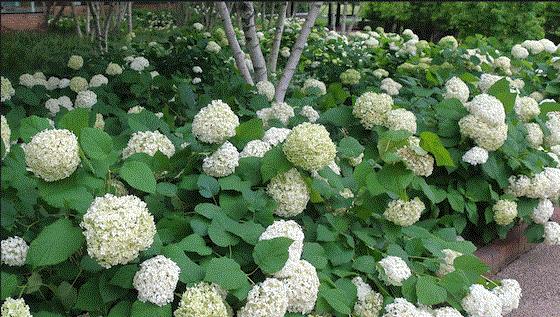
Ask and you shall receive, Susan! Lisa Lipsey from the Virgina Tech Department of Horticulture clued me into this five-year-long study of a wide range of hydrangeas, including some new cultivars, done by the Mt. Cuba Center in Delaware. They studied the overall performance and growth in both sun and shade, flower power and which species and cultivars did the best at attracting pollinators. It looks to be an excellent and comprehensive study and it shows that some cultivars (White Dome, Total Eclipse, Haas’ Halo and Pink Pincushion were standouts) attracted as many pollinators as did the native species.

Annabelle (continued)
Here's a comment from someone I should have thought to ask myself: Lorraine Ballato, author of “Success with Hydrangeas, a Gardener’s Guide.” Lorraine wrote in to say:
“I do a fair amount of speaking and tons of writing about hydrangeas. To say the least, this PR firm would do well to do a bit more research before going public with their ideas about Annabelle hydrangea. I couldn’t agree more with you and Tina Bemis. I would add a few more points to the discussion:
“First of all, I consider Annabelle to be a ‘gateway’ plant for the average gardener. It is beautiful and foolproof in cold climates. Even when it is nibbled by deer, it comes back. My audiences are continually interested to engage in discussions about it as they graduate to other hydrangeas. It definitely has a place in a mixed landscape.
“Second, despite the mophead flower form, seedlings of this plant pop up all over our property, as its seeds are pollinated and dropped by the local bird population. That is something I have not experienced with our lacecap hydrangeas (of which we have several), which have an abundant amount of pollen. Hmmm …
"I am especially fond of how Annabelle forms a nice colony. That lets me easily divide and share offshoots with others. I get very few refusals.
"We look out at a bank of Annabelle Hydrangeas from our kitchen window. It is our primary winter view, as most everything around them goes dormant. Over the course of 20-plus years, I have personally observed how our bird population takes refuge and buries themselves in the flowerheads throughout the year. During the growing season, those flowers protect them from predators, while in colder months, the spent flowers keep them out of the worst Connecticut weather.
“As far as I’m concerned (I admit I am a bit prejudiced), every garden should have at least one Annabelle. There are NO devastating effects, only upsides.”
Tom Contrisciano, eastern region territory manager for ICL Group, also mentioned the Mt. Cuba research. He suggests retailers suggest cultivars that are both beautiful AND are better pollinator attractors:
“As a native plant enthusiast who gardens using primarily U.S.-native plants (but not exclusively), I have an opinion on your recent article. I wasn’t put off by the original statements sent to you about Annabelle. Yes, planting something that doesn’t significantly benefit pollinators and other wildlife is better than planting nothing. However, our entire industry is based on offering plants that are ‘better’ in some way as determined by the marketplace. In the past, those attributes included bigger blooms, different colored foliage, shorter or larger finished size, better winter hardiness, etc. Our industry has no problem embracing and actively promoting all those types of attributes to potential customers in lieu of other varieties that don’t have them. We don’t collectively say gardeners don’t need bigger blooms or better winter hardiness because what we currently offer is better than nothing. We say our retailers are working hard to meet the current needs of the marketplace.
“Thankfully, we are now aware of the responsibility to supply plants into the marketplace that do more than just look pretty. An increasing number of consumers also want plants that support wildlife in a significant way. Lots of independent organizations, including Mt. Cuba in Delaware, publish information on the relative benefits of one variety versus another in supporting pollinators and wildlife. I see no reason why a retailer wouldn’t want to recommend, for example, Hydrangea arborescens Haas’ Halo, which is both gorgeous and superior at feeding pollinators, over a variety like Annabelle, which is gorgeous but doesn’t have the superior attribute of feeding pollinators. Both are better than nothing, but retailers can stock Haas’ Halo and promote its environmental benefits rather than stocking and offering those varieties that don’t.”
One last idea, from Stuart Burnley of Hermitage Farms Nursery in Virginia, about how to answer those who might automatically think natives are always superior:
“I have a friend who used to give talks/slide shows on native herbaceous perennials. He would start off the talk with questions for the audience on native vs. exotic plants, such as, ‘How many of you grow so and so?’ People would raise hands in reply. ‘How many of you have vegetable gardens? How many of you grow tomatoes?’ A show of hands by most. His reply? ‘Tomatoes are not native.’ And he would go on to talk about integrating natives and exotics in the garden and landscape.”

One more Annabelle opinion: "Valid concerns"
From reader Lauren Reitnouer, who says she's “pretty passionate” about the topic:
“I am a long-time Acres Online reader, have spent most of my life both professionally and personally in multiple facets of agriculture and floriculture, and have worked for a wholesale greenhouse for the better part of the last decade. I normally appreciate your perspective on the industry even if I disagree on an angle here and there; however, I was so disappointed with your coverage of the Annabelle Hydrangea segment that I feel compelled to reach out in hopes that you and others may re-think it.
“I am absolutely not an all-or-nothing gardener and agree whole-heartedly that any extremist perspective is just not practical. I grow vegetables and herbs of all kinds along with natives and non-natives for pollinators, birds and all other members of our local ecosystem. My neighbor has several honeybee hives, of which we enjoy the bounty, but I have also counted over 24 different species of native bees and wasps within our small parcel. There is room for both.
“In the same breath, it is rightly important to discuss how the plants we are using as gardeners affect our local ecosystems in both positive and negative light. It is the result of poor education in the industry that we have Bradford pears, Japanese privet, Lantana camara … the list could go on, degrading many ecosystems that our native plants, wildlife and pollinators rely on. In these examples, and many others not listed, planting nothing is most certainly better than planting those.
“The common dandelion is itself an invasive plant in North America; while it thrives in mowed and disturbed areas rather than outcompeting in sensitive ecosystems, I still think it is a very poor example of someone trying to argue a moderate approach that includes both angles. The fact of the matter is, we are not funding the research to see what the effects of some of these cultivars are on the populations of wildlife that rely on them for survival. I am not arguing to pull all these plants from the market, but to draw attention to the fact that these are valid concerns, and we certainly shouldn’t be actively promoting them for benefits that we are not certain they have. Without taking accountability for our actions in this industry, we will only continue to polarize the segments of people that should be enjoying the outdoors and nature together.”
Fair enough, Lauren. Although I still think Bradford pear rates higher than Annabelle on the “don’t plant” list.
Any other thoughts on the topic? Let me know HERE.

Watching computers grow tomatoes
Have I mentioned the Autonomous Greenhouse Challenge taking place as we speak at WUR—Wageningen University and Research in the Netherlands? You can actually watch the competition HERE:
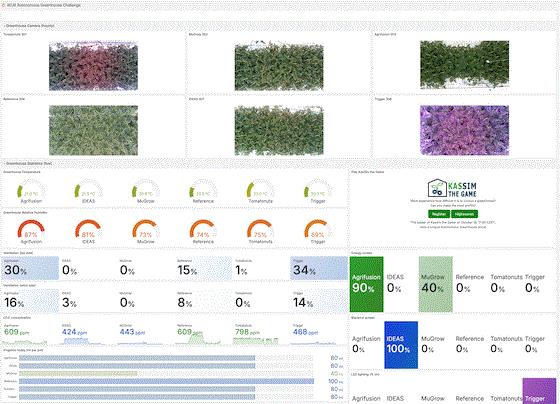
The Autonomous Greenhouse Challenge pits five teams of scientists and experts against each other, growing a crop of tomatoes in greenhouse cells at WUR. The goal is to produce as much fruit as possible with the lowest input costs—energy, fertilizer, water, etc. Just like real growing! Except in this case, the scientists won’t grow the crop, their algorithm will, making every decision about temperate, light, humidity, feed and water, etc. The teams can only sit back and watch their software at work, hoping they got it right. In the meantime, for comparison and control, a human team (“Reference”) is growing a crop the old-fashioned way.
Admittedly, it’s a bit like watching paint dry … or grass grow … or tomatoes, actually. But study the dashboard and decide why one team has a different setting than all the others. What are they trying to achieve? Like right now, as I write this, it’s 10:00 p.m. there and five of the six teams have no lights on. But the Tomatonauts are running their LEDs, making the temperature in the greenhouse 3 degrees C warmer and the humidity 10 or more points lower. They also irrigated much more today. Hmmm. They seem to be pushing the crop. Will they get away with it? I mean, will the algorithm get away with it? In three months we’ll know who the best grower is!

More on the PPWR rules from Europe
PPWR is Packaging and Packing Waste Regulation, which was approved by the European Parliament and is expected to be finalized by the European Council late this year or early next and take full effect by 2030. Its purpose is to establish packaging guidelines and prevent packaging waste—all part of Europe’s goal to be carbon neutral by 2050.
I touched on it recently with my coverage of the Euro Plant Tray, a reusable shuttle tray designed by European growers to be perfectly usable at the nursery and the garden center while meeting the coming European packaging rules. The industry decided just a couple years ago to get ahead of any pending regulations and it looks like they’ve succeeded.
Anyway, Royal FloraHolland, the big Dutch flower and plant auction, also wants to help their member growers and the industry at large deal with any pending PPWR rules. To that end, Royal FloraHolland has started an analysis of the rules to determine its potential impact on floriculture. Their findings thus far?
- All packaging must be recyclable.
- Plastic packaging must contain at least 35% recycled material.
- Packaging design must ensure that the weight, volume and number of layers of material are kept to a minimum.
- Preference for reusable packaging, such as multi-use transport packaging, with minimum targets within the EU. Exact definitions for reusable packaging are still being established.
- All packaging must have a label or QR code providing details of material composition to facilitate sorting by consumers or to enable reuse.
Royal FloraHolland will continue to monitor developments in relation to PPWR and are actively involved in raising awareness of its impact on the sector with policymakers.
I bring this up because here in North America we may someday face similar government regulations regarding packaging, plastics, energy use, water or something else that affects our businesses. Knowing how the European industry handles such situations could be instructive.

Plant warranties … again (still)
In the Facebook group Garden Center—IGCs, Suppliers and Media, one member posted a question that pops up anytime two or more garden center owners are in a room together: plant warranties. Here’s the question (which, last time I looked, had elicited 92 comments):
Why do we have to offer plant warranties? Are there any garden centers that don’t? I am seriously considering a no refund/no return policy. I am tired of being held financially responsible for a living entity once it leaves my garden center. It didn’t used to bother me, but all of a sudden I am feeling very annoyed by customers warranty expectations. I had a lady try to return a hanging basket because she didn’t water it! Really? It needs WATER! So many things outside of our control can affect a plant after it leaves our shop, it doesn’t seem right to hold the garden center responsible if it dies or gets bugs/fungus/eaten by an animal … What are your thoughts?
It seems a majority of respondents said they do NOT offer warranties and they have signage stating so. As someone said, “We sell plants that are beautiful, appropriate for our climate and very healthy. What happens to it after you buy it is out of our control.” But many will warranty more expensive trees and shrubs. Some will guarantee it only if they plant it. One even offers two prices: a regular price and a guaranteed price.
But two experienced garden center consultants weighed in in favor of guarantees. Judy Sharpton of Growing Places Marketing said, “Don’t let your emotions drive business decisions,” suggesting retailers track actual returns for a period of time to determine the actual dollar amount. “Most stores find this number to be very small,” she said.
Consultant Ian Baldwin offered more concrete evidence in support of plant guarantees:
“Folks, here’s the data: If you guarantee everything, like many answers on here are advocating, it might cost you around 0.5% to 1% of your sales—which is, of course, why you mark things up in the first place. If you guarantee everything and shout about it as a marketing message, it will cost you around 1% to 1.5% of your sales. Bad buying, poor training, bad customer service, even inaccurate watering, etc. will cost you more—a LOT more—in a year. Take it from your marketing budget—most of which have shrunken by 50% in the last decade anyway.”
In the end, my view is it’s called an “independent” garden center for a reason. Do what you want! There’s no right or wrong answer, just options.
But I also fully agree with Judy: Don’t let your emotions drive your business decisions.

Free webinar on waterborne pathogens and “green oxidation”
One good thing about Zoom and its ilk: It’s made it easier than ever to get educated from the comfort of your computer from sources around the world. Here's yet another online education opportunity, this time from Copenhagen, Denmark, where HPNow will be offering a free webinar titled “An Introduction to Onsite Green Oxidation.”
It’s September 26 at 3:00 p.m. Central European Time … which equates to 9:00 a.m. Eastern/8:00 a.m. Central. The speakers will be Cord Nunez and Arnau Verdaguer, both with HPNow, a supplier of onsite hydrogen peroxide generators for sanitation.
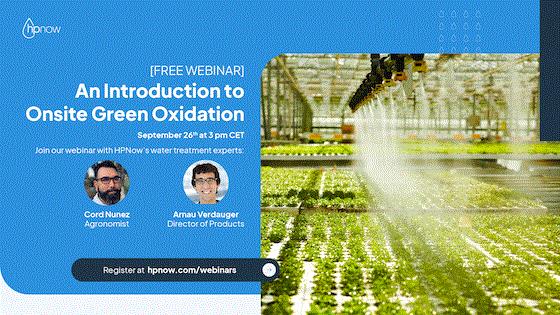
Now, I don’t know what “green oxidation” is—whether onsite or offsite—but I suspect it involves hydrogen peroxide, since that’s HPNow’s business. And they’ll be telling you how it can be used against waterborn pathogens. They say you’ll leave having learned these key points:
- Gain a deeper understanding of the prevalence and dangers of waterborne pathogens in greenhouse settings.
- Learn how Green Oxidation technology effectively eliminates harmful bacteria and fungi from irrigation water, safeguarding crops from these invisible threats.
- Discover the advantages of Green Oxidation for improved crop health, yield, and overall quality. This translates to stronger, more marketable plants and increased profitability for growers.
- Explore practical tips and strategies for implementing Green Oxidation in your greenhouse operation. The webinar will provide a clear roadmap for integrating this technology seamlessly into your existing systems.
Sign up HERE.

Stuppy strengthens presence in Colorado, Iowa
Kansas City, Missouri-based Stuppy Greenhouse, Inc. wants to enhance the service it provides to two “critical regions:” Colorado and Northeast Iowa. To do that, they’ve assigned Chad Gooley, Midwest Regional Sales Manager with 17 years of experience at Stuppy, to spearhead efforts in Colorado.
“Chad’s deep industry knowledge and commitment to client success make him the ideal resource to drive growth and innovation in this dynamic market,” said Stuppy in their press release.
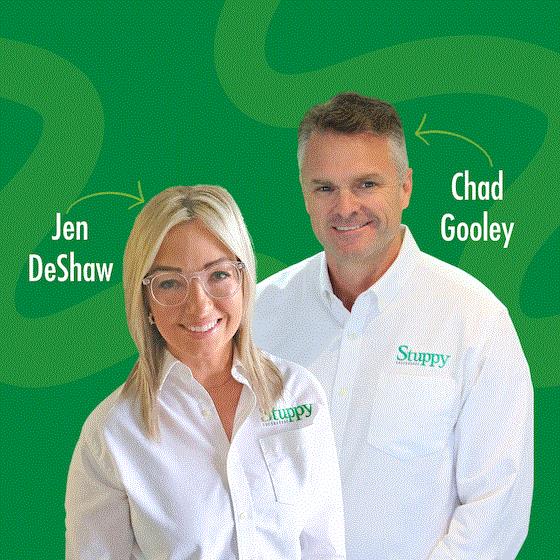
In northeast Iowa, their Upper Midwest Regional Sales Manager Jennifer (Jen) DeShaw will assume responsibility for the region. Jen brings more than 15 years of sales experience, including four years of specialized expertise in the horticulture industry.
“Her dedication to delivering tailored solutions and exceptional customer service will be instrumental as we continue to support our clients in Iowa,” said the release.
Stuppy is a 150-year-old family business providing controlled-environment solutions for commercial, educational and research applications.
BTW, Stuppy, I like your photo presentation—friendly!

Share this webinar with potential horticulturists
Here’s a webinar all about careers in horticulture that I think you should share with all the young people you know who are looking for something amazing to do with their lives. They could be the next Chad or Jen!
“Growing Careers: Exploring Opportunities in Horticulture,” hosted by Seed Your Future, is designed to provide college students with “invaluable insights into the diverse career paths available in the dynamic world of horticulture.”
I can vouch for the many options available—I’ve spoken to the local community college hort program a dozen or more times on the topic. Think about it: Horticulture is amazing! Horticulture is art, it’s technology, it’s science, it’s the food we eat, the landscapes we live and play in, the environments we thrive in. It’s the business of managing and using what we grow while maintaining the health of our soil, air, water and the well being of our children, our communities and our world. If that doesn’t get a young person excited, I don’t know what will!
This interactive webinar will feature professionals from various sectors of horticulture, including breeders, propagators, irrigation specialists, growers, automation and software developers, transportation company leaders, and marketing and communication specialists. Attendees will gain firsthand knowledge about their roles, responsibilities and career journeys, and get to ask questions, seek advice and gain insights into a possible career in horticulture.
The webinar is October 3, from 4:00 to 5:00 p.m. Eastern. For more information and to register, go HERE.

Finally …
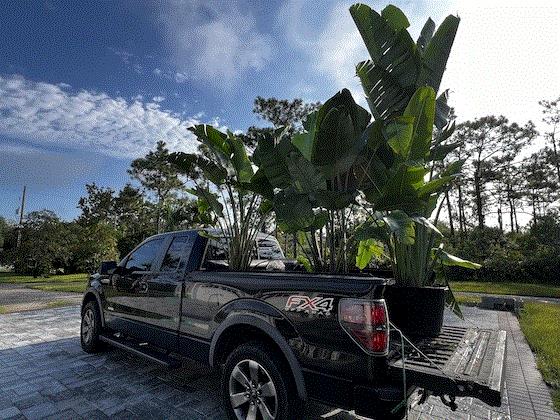
The other morning, I picked up two white bird of paradise and a traveler’s palm from a local wholesale nursery—all in 25-gal. pots, which is the max I’ve found I can wrestle around my property and into a hole without rupturing my spleen. (Don't worry, they didn't ride that way.)
While at the nursery, I picked up a clever trick for tying shadecloth or other tarp material that I thought I’d share: use a rock.
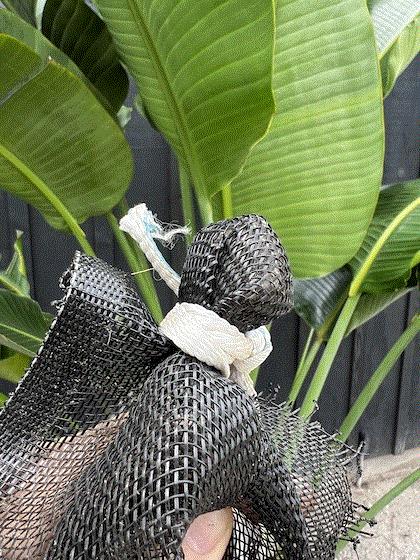
If you don’t have grommets through which to run your rope, it’s liable to slip off. But Hector and his helper simply picked up a few small stones from the driveway, nestled them in the corners of the shadecloth, then tied the rope around that. The stone secures the knot and keeps it from sliding off.
Slick … or in this case, no longer slick!
Feel free to email me at beytes@growertalks.com if you have ideas, comments or questions.
See you next time!

Chris Beytes
Editor-in-Chief
GrowerTalks and Green Profit
This e-mail received by 28,891 loyal readers!
Thanks to my loyal sponsors, who help me reach the 28,891 readers of Acres Online in more than 60 countries. Want to be one of them (a sponsor, that is)? Give Kim Brown a shout and she will tell you about our many advertising opportunities.